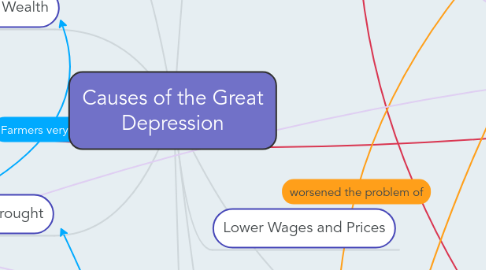
1. Severe Drought
1.1. Weather
1.1.1. Very low precipitation
1.1.1.1. Sky-rocketing pest populations
1.1.1.2. Highly unproductive agriculture
1.1.1.2.1. Abandoned farms
1.1.1.3. Dust storms
1.2. Unsustainable Farming Practices
1.2.1. Land overexploited during WWI
1.2.1.1. Demand from soldiers overseas
1.2.1.2. Supplies and food for war
1.2.1.2.1. Prairie land plowed/planted excessively
1.3. Demand slowed down for agriculture post-WWI
1.3.1. Land abandoned - used for cattle ranching
1.3.1.1. Destroyed soil consistency
1.3.1.2. Vulnerable to wind
2. Unequal Distribution of Wealth
3. Introduction of Credit
3.1. Purchase of Items on Credit
3.1.1. Purchase of Expensive Items
3.1.1.1. Demand for Products
3.1.1.1.1. Increased Production of Products
3.2. Encouraged Investment in the Stock Market
3.2.1. Buying on Margin
3.2.1.1. Consumers Bought More Stocks
3.2.1.1.1. Large Loss when Stock Prices Dropped
3.2.2. Businesses Borrowed Money to Expand
3.2.2.1. Businesses Neglected Worker's Salaries
3.2.2.1.1. Consumers Relied on Credit to Buy Goods
3.2.2.1.2. Less Income
3.2.2.2. Rise in Overproduction of Goods
4. Lower Wages and Prices
5. Stock Market Crash of 1929
5.1. About
5.1.1. One of the worst crashes in US history
5.1.1.1. Prices started to decrease in September and early October of 1929
5.1.1.1.1. Public still held onto the expectation that the market would continue to rise
5.1.1.1.2. Prices went into a free fall on October 18
5.1.2. Also known as the Wall Street Crash of 1929, the Great Crash, and Black Tuesday
5.1.3. One of the contributing factors towards the Great Depression
5.1.4. The event that brought the Roaring Twenties to a screeching halt
5.2. Causes
5.2.1. Roaring Twenties
5.2.1.1. "Hoover Bull Market"
5.2.1.1.1. Public rushed to buy stocks in order to get rich
5.2.1.2. Rapid economic growth
5.2.1.2.1. This rapid growth would inevitably lead to a recession
5.2.2. "Wild Speculation"
5.2.2.1. People made decisions based on the assumption that the overly bullish market would continue to rise
5.2.2.2. Caused the stock market the expand even more rapidly
5.3. Significance
5.3.1. Substantially reduced spending of American consumers
5.3.1.1. Purchases of durable goods and business investments (from the public) dropped harshly after the crash
5.3.2. Made the public more uncertain about their future incomes
5.3.2.1. They started to spend less money
5.3.3. While stock prices recovered after the next few weeks after the crash, overall prices continued to drop
5.3.3.1. In 1932, stocks were only about 20% of their value in the summer of 1929
5.3.4. While the Wall Street Crash of 1929 was not the only cause of the Great Depression, it was a factor that contributed to both production and employment declines in the United States
5.3.4.1. "By 1933, nearly half of America's banks had failed, and unemployment was approaching 15 million people, or 30% of the workforce"
5.3.5. It was a catalyst in helping the global economic collapse, which was also a factor that caused the crash itself
6. Overproduction
6.1. Increased production on farms during WWI
6.1.1. Needed to support European allies overseas
6.1.2. High levels of production continued after the war ended
6.1.2.1. Demand for farm products from trade partners decreased
6.1.2.1.1. European countries were still recovering from the war; their economies were struggling
6.1.2.1.2. European countries were producing their own farm products
6.1.2.1.3. There was competition from other countries
6.2. Introduction of new technologies
6.3. Increased production of manufactured goods
6.3.1. Increased advertising and demand
6.3.1.1. Many people bought on credit
6.3.1.2. Demand slowed after more people obtained these manufactured products
6.3.1.2.1. Surplus of products resulted in no work for factories
7. Business Cycles
7.1. What?
7.1.1. Fluctuations in the economy that occur in wave-like patterns
7.1.1.1. Adjustment of inventories/manufacturing of goods
7.1.1.2. Influences are both domestic and itnernational
7.1.2. Economic booms
7.1.2.1. Then economic busts
7.2. Impact
7.2.1. Statistics
7.2.1.1. Industrial productions falls over 50%
7.2.1.1.1. Construction of industrial plants falls over 90%
7.2.1.2. Automobile production falls by 60%
7.2.1.3. American unemployment rate reached 24.1% in 1933
7.2.2. Too much supply and not enough demand
7.2.2.1. Factory owners lay off workers because of loss of revenue
7.2.2.1.1. Former workers cannot afford to pay for manufactured goods
7.2.3. Disconnect between needs of economy and decisions of individuals
7.2.3.1. worsening economy
7.2.3.1.1. people did what was rational to save themselves
8. Bank Failures
8.1. What?
8.1.1. Occurred during Great Depression.
8.1.2. Bank run is sudden withdrawal of deposits of just one bank
8.1.2.1. When many banks suffered runs at the same time, it caused a banking panic
8.2. Causes
8.2.1. Panic Withdrawal of money that banks did not have
8.2.2. Too many banks; 1 bank for ever 1 000 people
8.2.2.1. Banks struggling to take in sufficient deposits
8.2.2.1.1. Bank Suspension
8.2.2.1.2. Banks did not have enough reserves to loan out to farmers and businesses
8.2.3. Distribution of bank deposits throughout banking system pyramid. Nonmember banks kept most deposits in correspondent banks in other cities. If bank needed money, it turned to correspondent bank for reserves; if that bank had insufficient funds, in turn, it too would have to request help from it's own correspondent bank
8.2.3.1. limited country banks' access to cash reserves during times of desparity
8.2.3.2. Inability to mobilize cash reserves in times of crisis
8.2.4. Practice of counting checks while collecting them meant that checks were deposited in one bank but its cash reserves were held in another bank.
8.2.4.1. Banks reserving deposited checks had fictitious money
8.2.4.2. During banking emergencies, banking system as a whole had less banks with actual cash reserves
8.2.5. High Demand of Money, not enough money supply in system
8.3. Impact
8.3.1. Statistics
8.3.1.1. "During the 20s, there was an average of 70 banks failing each year nationally. After the crash during the first 10 months of 1930, 744 banks failed – 10 times as many. In all, 9,000 banks failed during the decade of the 30s. It's estimated that 4,000 banks failed during the one year of 1933 alone."
8.3.1.2. By 1933, $140 billion worth of deposits was lost
8.3.1.3. Most depositors lost more than 20% of their savings since most state deposit insurance schemes had shut down

